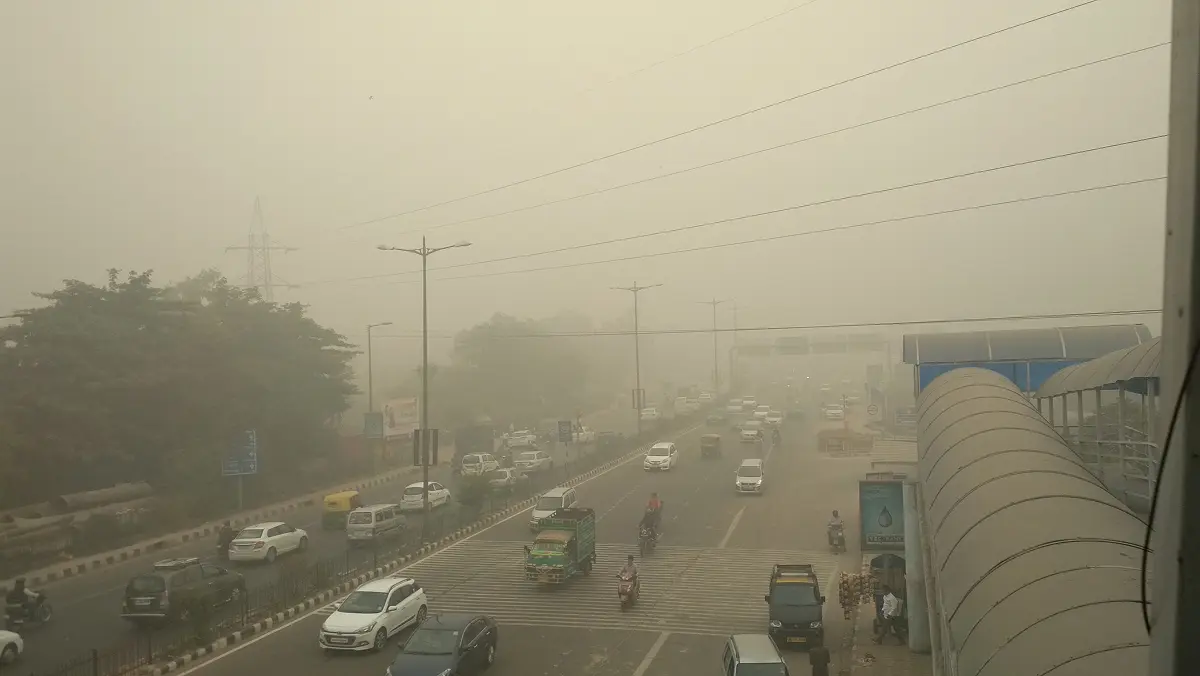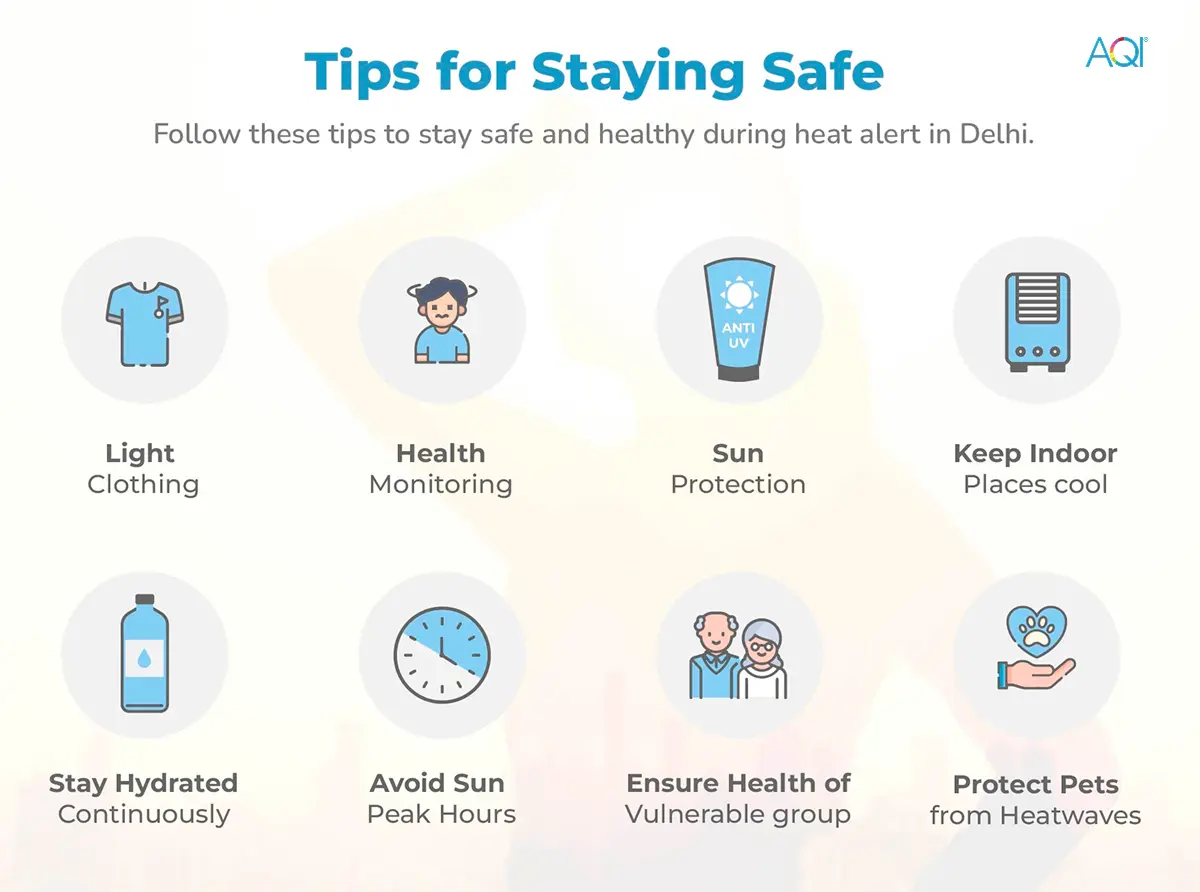2025 heatwaves are gripping again in Delhi, the heart and capital of India. Since the second week of June has brought scorching temperatures and some dust storms. Because the India Meteorological Department (IMD) has issued an orange alert for Delhi, resulting heat alert in Delhi. While May offered temporary relief through unexpected rainfall and western disturbances, June has unfolded differently, bringing rising temperatures and relentless sun.
Even the early mornings now feel unbearable because people are reporting discomfort and excessive heat from the first rays of the sun. As per IMD, the actual temperature reached 43.4°C on June 9, but the “feels like” temperature shot up to 49°C, mainly due to humidity and ground heat.
Alongside the heat, the IMD has forecast dust storms and thunderstorms for the week. While this brings hope for some relief, it also raises concerns about air quality and visibility, both of which are expected to be significantly impacted.
What IMD Has Warned Delhi About: heat alert in Delhi?
The IMD (India Meteorological Department) has issued a heatwave and dust storm warning for June 9 and June 10. The orange alert means people should stay cautious, especially in the afternoon. Along with the heat, strong surface winds and dust are expected, making conditions uncomfortable and potentially unsafe.

Weather Forecast for June 8–14, 2025: heat alert
Let’s take a look at how the week is expected to unfold:
- June 8 (Saturday): Clear skies. Temp: 28°C (min) – 42°C (max)
- June 9–10 (Sun–Mon): Peak heat. Max temp ~44°C. Strong surface winds.
- June 11 (Tuesday): Mostly clear. Max temp: 43°C.
- June 12 (Wednesday): Thunderstorms with light rain are likely. Some relief expected, still Max Temp: 42˚C expected.
- June 13–14 (Thu–Fri): Rain and thundershowers continue. The temperature may drop to 38–39°C.
Throughout the week, winds of 20–30 km/h will blow in from the northwest, raising dust and impacting visibility, especially during the morning and early evening hours.
What Has Happened in Delhi So Far?
Since Sunday, June 8, residents have been reporting intensified heat. The sun feels harsher than usual, with people experiencing sunburn, dehydration, and fatigue. Commuters, especially those who travel during the morning and afternoon hours, are facing immense discomfort. These symptoms are early signs of heat-related illnesses, and reports suggest a rise in heat exhaustion and similar issues.
The heat has also led to increased electricity usage across the city, with homes and businesses relying heavily on air conditioning and fans. This puts added pressure on the city’s energy infrastructure and raises concerns about sustainability during extreme weather conditions.
Impact of the Heatwave on Delhiites
This year’s heatwave is not just intense — it’s also prolonged and humid, pushing the city’s limits. On June 9, while the actual temperature reached 43.4˚C, the real-feel shot up to 49˚C due to the combination of heat, surface winds, and ground radiation. Such extreme heat particularly endangers vulnerable groups like children, the elderly, and those with existing health conditions.
Health experts have warned of an increase in heatstroke and dehydration cases. Dizziness, rapid heartbeat, confusion, and nausea are common symptoms now being reported. The high humidity levels and lack of breeze in some areas are only worsening the heat stress, leading to increased visits to health centres.
Dust Storms and Its Effects on Delhiites

The dust storms predicted by the IMD are a serious concern alongside the heatwave. These storms lower visibility on roads, disrupt public movement, and worsen air quality, pushing AQI levels into the “poor” or even “very poor” category. For individuals suffering from respiratory issues such as asthma or bronchitis, this can be .
The previous dust storm in May had already left a strong mark on Delhi’s air, and a similar pattern is emerging this week. These storms carry fine dust particles that can easily irritate the lungs and eyes, leading to a spike in respiratory illnesses. Visibility issues during storms also pose a threat to road safety, especially for two-wheeler riders and open commuters.
Official Advisories and Weather Context During Heat Alert in Delhi:
IMD has shared clear public health guidelines to tackle the ongoing heat and dust. Delhiites are advised to drink water frequently, wear light cotton clothes, and stay indoors during peak sunlight hours — typically from 12 PM to 4 PM. For those stepping out, using sun protection like umbrellas, sunglasses, and sunscreen is essential.
Tips for Staying Safe
To navigate these conditions, residents are encouraged to follow several practical measures, as outlined in the following table:

| Tip Category | Specific Actions |
| Hydration | Try to stay hydrated as much as you can by drinking plenty of water and electrolyte-rich fluids to prevent dehydration. |
| Timing | Limit outdoor activities between 12 PM and 4 PM to reduce exposure to heat and dust. |
| Clothing | Choose only light-colours clothes with loose-fitting to stay cool and protect against dust. |
| Sun Protection | Wear hats, sunglasses, and apply sunscreen if you must go outside, especially during dust storms. |
| Indoor Cooling | Use air conditioning or fans to keep your home or workplace comfortable. |
| Vulnerable Individuals | Check on elderly neighbours or relatives to ensure they have access to cooling resources. |
| Health Monitoring | Be aware of signs of heat-related illnesses like dizziness, nausea, or confusion, and seek medical attention if necessary. |
| Pet Care | Keep pets indoors and ensure they have access to water and shade. |
| Dust Storm Precautions | Use masks or cloths to cover the face during dust storms to protect against inhalation of dust particles, and avoid outdoor activities during high wind periods. |
People are also advised to stay updated with weather forecasts and alerts, especially as sudden dust storms or thunderstorms can occur. These alerts can help people plan their day better and avoid unnecessary exposure to hazardous weather conditions. This heatwave is being seen as one of the more extreme ones in recent years, following earlier heat alerts in April. As June progresses, these patterns seem to confirm that the capital is dealing with another climate-related stress period.
Conclusion
Delhi is currently enduring one of its toughest weather phases this year, with both heat waves and dust storms creating a harsh environment. With the real-feel temperature reaching 49˚C and heat alert in Delhi, it becomes crucial for residents to follow safety measures and stay updated through reliable platforms like AQI.in, which track both air quality and weather changes in real-time.
While a short spell of rain might offer some relief later in the week, the immediate days ahead require caution, awareness, and proactive care. Delhi has faced such challenges before — and with informed action, it can weather through again.